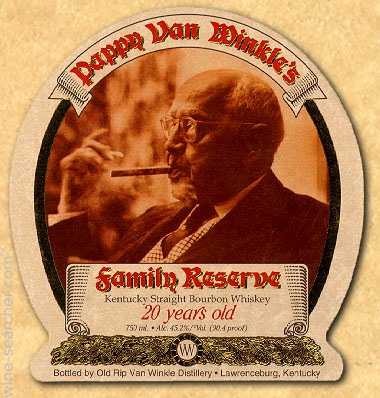Ever wondered how and why Pappy Van Winkle’s bourbon earned its stellar reputation?
Some say it all began when Julian Van Winkle III stumbled upon an old picture of his grandfather, Julian “Pappy” Van Winkle, smoking a stogie in the mid 1990’s. He decided it would be the perfect label to affix upon the now acclaimed bottle of Pappy Van Winkle’s Family Reserve 20 Year when it was released in a green bottle in 1994. A few years later in 1998, the second expression –- aged 3 years longer –- Pappy Van Winkle’s Family Reserve 23 Year came to be.
The first Pappy 20 was not today’s Buffalo Trace distillate, nor was it the renowned Stitzel-Weller juice. Instead it was made with bourbon distilled at Old Boone Distillery. In fact, the bottle of Pappy 20 that a Chicago distributor sent to the Beverage Tasting Institute (without Julian III’s knowledge) that scored the first 99 BTI ever gave came from this batch. And surprisingly enough, it WAS NOT a WHEATED bourbon, but used rye as the flavoring grain.
Wheated Smoothness
Now if you don’t know much about Pappy that might not sound like a big deal, but if you know just a little, you realize that one of the characteristics that set Pappy apart and made it famous was its smoothness. Replacing the rye with wheat in the mash bill created this smoothness. Up until that time, most distilleries used rye to flavor their bourbon, which gives it a spicer taste. (Remember Bourbon has to be at least 51% corn too.)
Eventually, the rye-based Pappy Van Winkle ran dry in 1998, and this is where the story gets interesting. Julian III decide to start using wheated Bourbon from Stitzel-Weller in the future bottlings of Pappy. His dad, Julian Van Winkle, Jr., had received rights to the old Stitzel-Weller stocks when the distillery was sold in 1972 as the demand for bourbon dried up. The company also switched from green bottles to clear bottles. This NEW wheated recipe of Pappy also scored a groundbreaking 99 from the Beverage Tasting Institute in 1996. This triggered the rise of Pappy Van Winkle as the most famous Bourbon on the planet.
Check back for Part 2 of the Pappy Van Winkle Phenomenon to discover how Father Time, Celebrity Chefs -- and Scarcity played a part in the ascent of Pappy.
